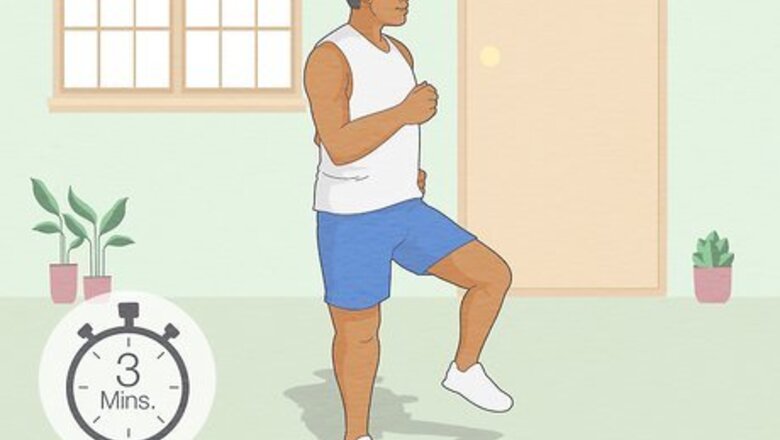
views
Doing Cardio at Home
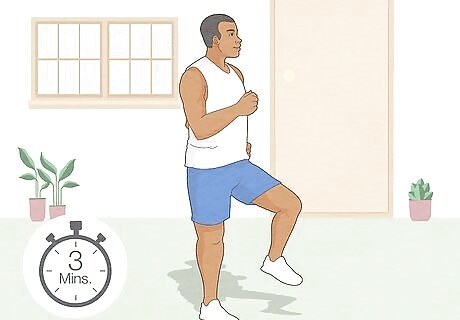
Warm up for 5-6 minutes with some light movement. Before you start your home cardio routine, get your blood pumping for a few minutes and warm up your muscles. For example, you might try the following warmup routine:Tip: This is just one possible warmup routine! You can find tons of quick warmup videos on YouTube, or use an app like 5 Minute WARM UP to guide you through your pre-workout routine. March in place for 3 minutes. Lift your legs high and pump your arms while you march. First go forwards, then switch up and go backwards. Stand with your fists out in front of you. Alternate placing each of your heels on the floor in front of you for 60 seconds. Aim for 60 heel digs in 60 seconds. Stand up straight and alternate bringing up each knee to touch the opposite hand. Keep doing this for 30 seconds and try to do 30 knee lifts total. Do 2 sets of 10 repetitions of shoulder rolls. With your arms hanging loose at your sides, roll your shoulders forward 5 times and backward 5 times, then repeat the process. You can also do this while marching in place! Stand with your knees shoulder-width apart and your arms stretched straight out in front of you. Keep your back straight and bend your knees gradually to lower yourself by about 4 inches (10 cm), then gradually come back up again. Repeat this 10 times.
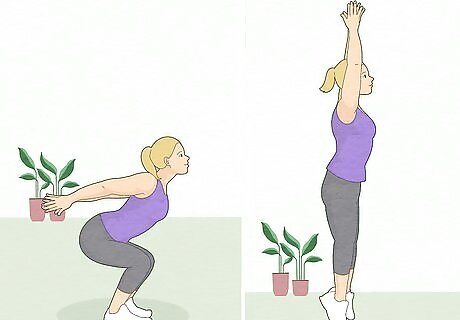
Do 2 sets of 15-24 rocket jumps. Rocket jumps are a fun and exhilarating way to start your workout! Put your feet hip-width apart and bend your knees slightly. Bend down and put your hands on your thighs. Then, jump up and stretch out your whole body, reaching straight toward the sky with both hands. Try to land gently, then get your feet and knees back into the starting position before jumping up again. Repeat this 15-24 times. Rest for a minute or 2, then do another set. As you get used to this exercise, you can make it more challenging by starting in a deeper squat. You can also try holding a light weight or water bottle in your hands at the center of your chest and raising it above your head as you jump. When you’re done, do 15-45 seconds of walking or jogging in place.
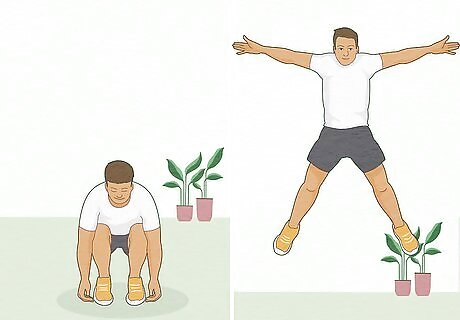
Get your whole body moving with 2 sets of star jumps. Star jumps are similar to jumping jacks, but with the twist that you do them while airborne. Start with your feet hip-width apart and your knees slightly bent, and let your arms hang by your sides. Jump up and extend your arms and legs so that your body makes a star shape, with your feet apart and your arms slightly raised at your sides. When you land, bring your knees together and let your hands fall at your sides. Repeat this exercise 15-24 times, rest briefly, and then do another set of 15-24 jumps. To work out your core, keep your abs tight and your back straight.
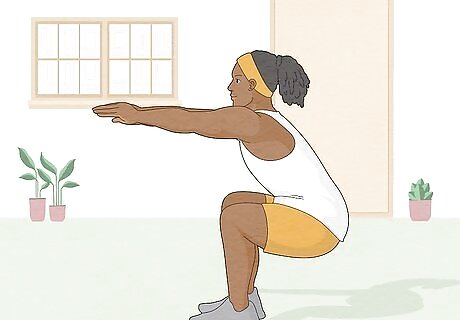
Exercise your lower body with some squats. Squats are a good cardio workout, and they’re also great for toning your back, legs, and rear. To do squats, start with your feet shoulder width apart. Stretch your arms straight out in front of you and bend your knees, keeping your back straight. Slowly lower yourself down until your knees are at close to a right angle and your thighs are parallel with the floor. Then, slowly return to your starting position. Don’t let your knees extend past your toes. When you’re done, limber up your legs by walking or jogging in place for 15-45 seconds. EXPERT TIP Laila Ajani Laila Ajani Fitness Trainer Laila Ajani is a Fitness Trainer and founder of Push Personal Fitness, a personal training organization based in the San Francisco Bay Area. With over 10 years as a trainer and exercise specialist, Laila has expertise in competitive athletics (gymnastics, powerlifting, and tennis), personal training, distance running, and Olympic lifting. Laila is certified by the National Strength & Conditioning Association (NSCA), USA Powerlifting (USAPL), and she is a Corrective Exercise Specialist (CES). Laila Ajani Laila Ajani Fitness Trainer For beginners, chair or box squats can be a good variation. Doing a high rep of easier squats can help you build strength and train your body to reach the proper squat positions. If you're currently unable to do squats, start with lunges until you gain strength, and then try squats later on.

Work out your arms and legs with 2 sets of tap backs. This is a fun workout that feels a bit like a dance move. Stand up straight and step back with your right foot while swinging your arms straight out in front of you at the same time. Then, repeat the same movement with your opposite leg. Continue switching fluidly between legs for 15-24 reps, then rest for a moment and repeat for another set. Keep your hips and shoulders square and look straight ahead. Don’t let your front knee extend beyond your toes as you’re bringing your leg back. When you’re done, walk or jog in place for 15-45 seconds. You can make this exercise a little more challenging by jumping when you switch legs. Just make sure to keep your knees unlocked so you don’t hurt them when you land!

Wrap it up with some burpees. Start out in a standing position, then drop down into a squat and put your hands on the ground in front of you. Put your feet back behind you so you’re in a pushup position, then jump forward so you’re in a squat again. From there, jump straight up and reach for the sky with both hands. Do 2 sets of 15-24 reps. If a full burpee is really difficult for you, skip entering the push-up position and just jump up straight from the squat. You can also try standing up slowly instead of jumping into the final position. Did You Know? According to fitness experts, burpees are one of the best whole-body exercises you can easily do at home!
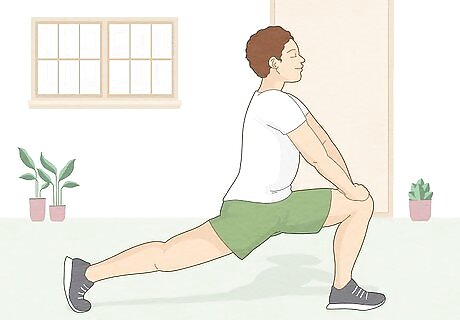
Cool down with some gentle stretches. When you’re done, cool down for at least 5 minutes to help your heart return to a resting rate gradually. Try walking or jogging lightly in place for a few minutes, then limber up your muscles with some light stretches or yoga. For example, you might: Do a buttock stretch. Lie on your back and bring both knees up to your chest, then cross your right leg over your left. Grab your left thigh with both hands and pull your knee closer to your chest. Hold this position for 10-15 seconds before switching. Stretch your hamstrings. Lie flat on your back with your knees bent. Grab one leg below your knee with both hands and pull your leg toward you while keeping it straight. Hold it for 10-15 seconds, then switch to the other leg. Sit down with your back straight and your feet together in the “butterfly” position, then slowly slower your thighs toward the floor. Hold for 10-15 seconds, then release. Stretch your calves by alternating stepping forward with 1 foot while you keep your other leg stretched out behind you. Hold on each side for 10-15 seconds. Lie down on one side with your knees together. Grab the top of whichever foot is on top and pull it toward your buttocks. Try to touch your buttocks with your heel. Hold your position for 10-15 seconds, then turn over and repeat on the opposite side.
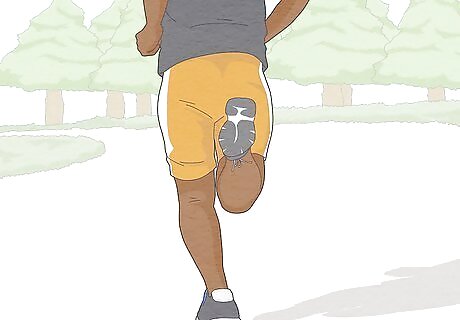
Mix up your routine by getting outside if you can. Getting out of the house can boost your mood and make exercising more fun. If you’re able to leave your home and go outside, try incorporating walks, jogs, or other outdoor activities into your cardio routine. For example, you could: Take a brisk walk or jog around your yard or neighborhood Go biking Jump rope or bounce on a trampoline in your yard Do some yard work, like gardening, raking leaves, or mowing the lawn
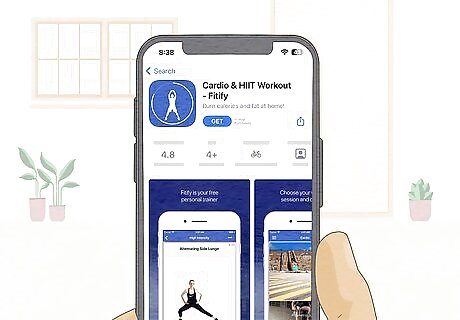
Watch a cardio warmup video if it helps you to follow along. Watching a coach or instructor go through a workout routine can make it easier to set a good pace and get the workout you need. Find some videos you like on YouTube, or use some of these great home workout videos from the U.K. National Health Service: https://www.nhs.uk/oneyou/for-your-body/move-more/home-workout-videos/. Some apps also offer timed cardio workouts that you can follow along with. Try an app like HIIT & Cardio Workout by Fitify, Daily Cardio Workout, or Cardio Workout: Home Cardio Trainer.
Strength Training without Gym Equipment

Build your arm and shoulder strength with pushups. Pushups are a classic upper body strengthening exercise that you can do anywhere. To begin, kneel down on a mat or the floor and bring your knees and feet together. Stretch out on your belly and rest on your palms, with your hands shoulder-width apart and lined up with your shoulders. Rest your toes on the floor and keep your legs together. Tighten your core and keep your back straight as you push up from the floor with your arms until your elbows are straight, then slowly lower yourself back to the floor. Ideally, you should not let your belly touch the floor before pushing back up again. Try doing 3 sets of 10 reps to start. As you get more comfortable with pushups, you’ll be able to do more in a set. If you’re not comfortable with a full pushup yet, allow your knees and shins to rest on the floor and just push up your upper body. This is a great way to build the upper body strength you need to eventually pull off a full pushup!
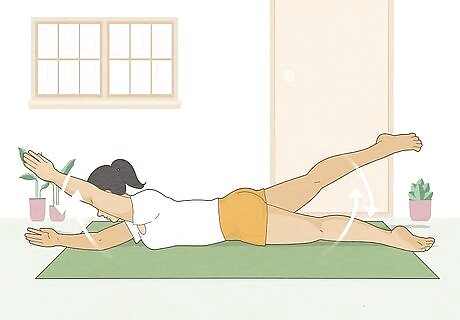
Strengthen your shoulders and back with contralateral limb raises. This fancy-sounding exercise is actually a simple way to work out your upper body, back, and hips. Lie flat on the floor or a mat and stretch your legs out behind you with your toes pointing backwards. Stretch your arms out straight in front of you with your palms facing each other. Exhale and tighten your core, then slowly raise your arm a few inches off the floor while inhaling. Exhale as you slowly lower it down again. Alternate doing this with each of your limbs in succession. Try to keep your back, hips, and head as still as possible while you do this exercise.

Do some planks to build strength in your core. Planks are a great core-building exercise that work more effectively than push-ups and are easier to do! To execute a basic plank correctly, lie down on the floor or on a mat and place your palms on the floor, shoulder-width apart. Broaden your shoulders as much as possible to engage your back and core. Push straight up through your arms and put your toes under you so that your entire torso and legs are off the floor, keeping your legs and back as straight as possible. Try to hold this position for 20-60 seconds.Tip: Want to target your abs? Try this 10-minute workout that guides you through a series of powerful core-building moves: https://www.nhs.uk/video/pages/body-blast-working-your-abs.aspx Don’t forget to breathe! Inhale steadily in through your nose and out through your mouth while you hold the plank. Lower yourself slowly and gently back to your starting position when you’re done.
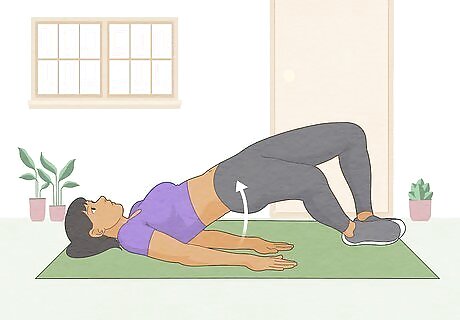
Engage your glutes and core with frog bridges. Frog bridges are a great way to build your butt and strengthen your abs and lower back. Lie down on your back and put the soles of your feet together, letting your knees fall open into a “frog leg” position. Tighten your glutes and abs and slowly raise your hips off the floor until your body forms a straight line from your shoulders to your knees. Then, hold your position for a couple seconds and tighten your glutes before slowly lowering yourself back down to the floor. Keep doing this exercise as a series of smooth, flowing movements for 30 seconds. Breathe steadily in and out as you go through the whole exercise.
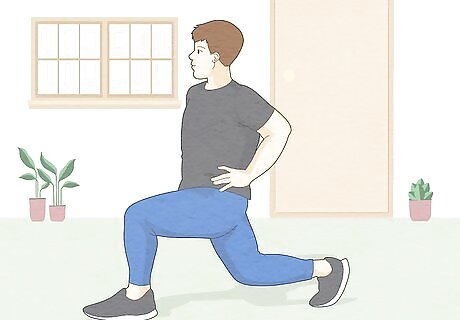
Work your legs and butt with lunges. Lunges are a good dynamic stretch, but they also help build strength in your lower body and legs. Start by standing with your feet together, then pull your shoulders down and back. Tighten your core and keep your back straight. Slowly lift one foot and then step forward into a deep lunge with your other leg out behind you and both knees bent. Hit the floor with your heel first when you step forward. Push off with your front leg to return to the starting position. When you enter the lunge, lower your hips straight down instead of pushing them forward. Try not to sway or lean from one side to the other. Tighten your thighs and butt as you return to the starting position.
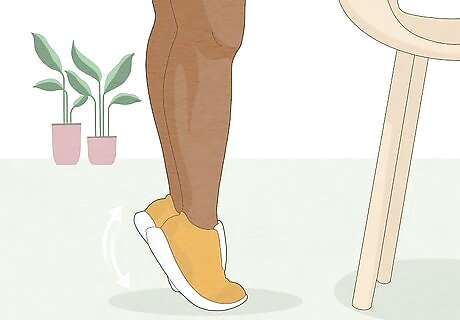
Tone your calves with heel raises. Heel raises can help strengthen and tone your lower legs. To do a simple standing heel raise, stand in front of a chair or counter. Grab the back of the chair or rest your hands on the counter, then slowly raise onto your toes, keeping your knees and back straight. Then, gently lower yourself back down onto your heels. Do 2 sets of 10-15 reps. You can also incorporate heel raises into your squats to work out your calves as well as your upper legs!

Use water bottles or milk jugs to add weight to your workout. If you want an extra challenge, grab a couple of water bottles or 1 gallon (3.8 L) milk jugs before you start your routine. You can always adjust the amount of liquid in the jug according to your fitness and comfort level. Try exercises such as: Milk jug lunges. Hold 1 or 2 jugs in your hands and let them hang at your sides while you perform lunges as you normally would. Calf raises with milk jugs. Stand holding a jug in each hand and slowly raise yourself up on your toes. Hold the position for 2 seconds, then lower yourself down again. Milk jug squats. Sit on a chair and hold a milk jug between your thighs with both hands with your feet flat on the ground. Slowly stand up while pushing up from your heels while tensing your glutes, then slowly return to a sitting position. Push up again as soon as your buttocks touch the chair.
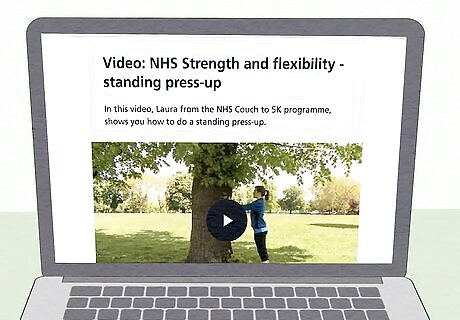
Follow along with strength training videos for extra motivation. If you feel lost without a coach or personal trainer by your side, workout videos can be a good substitute. Search YouTube for videos that focus on working out the different muscle groups, or try a strength and flexibility training routine like this one: https://www.nhs.uk/live-well/exercise/strength-and-flex-exercise-plan-how-videos/. You can also use apps with guided strength training routines, such as JEFIT, StrongLifts 5X5, and GAIN Fitness Cross Trainer.
Creating a Healthy Home Workout Routine

Establish a regular workout schedule. It’s easier to stick to the workout process if you establish a consistent routine. Aim to do regular workouts at the same times each day throughout the week. That way, it will eventually become a habit for you! Select certain days and times for your workout session. For example, you might do strength training every Monday and Friday at 7:00 am. If you fall behind for a day or two, don’t get mad at yourself. It takes time to establish a new routine, and setbacks are part of the journey. Just make sure to get yourself back on track right away! You can even plan to do your workout at the same time as some other activity that you regularly do. For instance, you might do a 30-minute aerobic workout while watching your favorite show on TV! EXPERT TIP Laila Ajani Laila Ajani Fitness Trainer Laila Ajani is a Fitness Trainer and founder of Push Personal Fitness, a personal training organization based in the San Francisco Bay Area. With over 10 years as a trainer and exercise specialist, Laila has expertise in competitive athletics (gymnastics, powerlifting, and tennis), personal training, distance running, and Olympic lifting. Laila is certified by the National Strength & Conditioning Association (NSCA), USA Powerlifting (USAPL), and she is a Corrective Exercise Specialist (CES). Laila Ajani Laila Ajani Fitness Trainer It's okay if you don't feel motivated every day, but it's crucial to establish a sense of discipline. A consistent workout routine is the key to achieving fitness goals. It is essential to remain determined and committed to your plan. Select a suitable time of day that fits your schedule. Dedicate around 30 to 60 minutes to exercise, and stick with it.

Aim to do at least 150 minutes of moderate cardio activity per week. While your exercise needs may vary depending on factors like your fitness goals, age, and overall health, doctors recommend that most adults get about 30 minutes of moderate cardio 5 days out of the week. Alternatively, do more intense cardio for 75 minutes per week (or 15 minutes a day, 5 days a week). “Moderate” cardio exercises include things like taking a brisk walk or light jog, biking at a speed lower than 10 miles (16 km) per hour, or doing house or yard chores that include a lot of moving around, like raking your lawn or vacuuming. “High intensity” cardio might include things like running, hiking uphill, biking faster than 10 miles (16 km) per hour, or jumping rope. Don’t worry if you can’t hit these goals right away. If you’re not used to doing cardio, gradually increase the time and intensity of your exercise. For example, you might start with a 10-minute walk around your yard or neighborhood 3 times a week, but eventually work up to a daily 30-minute jog.
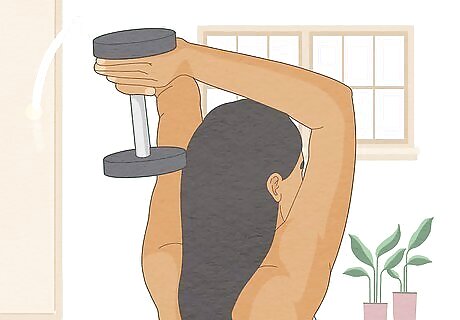
Do a strength training workout at least twice a week. Strength training is any exercise that uses resistance (such as weights, resistance bands, or your own body weight) to build your muscles. Incorporate a strengthening workout into your routine at least 2 days out of the week, and make sure to focus on all your major muscle groups. Aim for a single set of 12-15 reps of each exercise during a workout. You may need to gradually work up to more reps or stronger levels of resistance (e.g., heavier weights) as you build strength. Strength training exercises include things like doing planks and pushups, lifting weights, or doing exercises with resistance bands. Give yourself at least 2 days to rest and recover between each strength training workout. Otherwise, you might injure yourself.

Incorporate stretches to help build flexibility. Stretching is a great way to limber up your muscles and joints and prevent stiffness and pain. Try to do stretches when your muscles are already warmed up (e.g., after a cardio workout or strength training routine) for the best results. Aim to perform each stretch 3-5 times per workout. Dynamic stretches are fluid movements that you don’t hold for more than a few seconds. These include things like lunges and kicks. Unlike more traditional static stretches, you can do these kinds of stretches to help you warm up before other types of exercise. Static stretches involve holding a stretch for around 10-30 seconds. These are good for lengthening your muscles and improving your range of motion. Some examples include toe touches, wall pushes, and hamstring stretches with your foot propped on a chair or step.
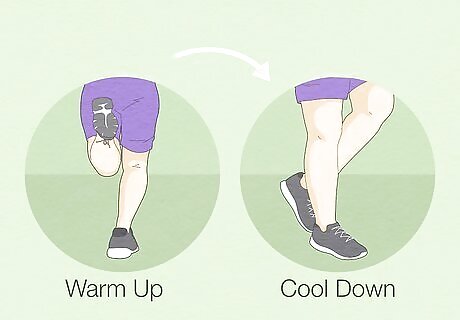
Warm up and cool down at the beginning and end of each workout. Warming up and cooling down are important for preventing injuries and reducing strain on your heart. Before you exercise, get your blood pumping with a light, 5 to 10-minute warmup, such as a walk, slow jog, or some pushups. When you’re done exercising, cool down again with a relaxed 5-minute walk and some light stretches. If you’re planning to do more intense activity, warm up a little longer. For instance, you might warm up for 10-20 minutes instead of 5 if you’re planning to do a brisk run. When you’re cooling down after a workout, try to get your heart rate down below 120 beats per minute. If you don’t have a heart rate monitor, you can measure it by taking your pulse and using a watch or timer.
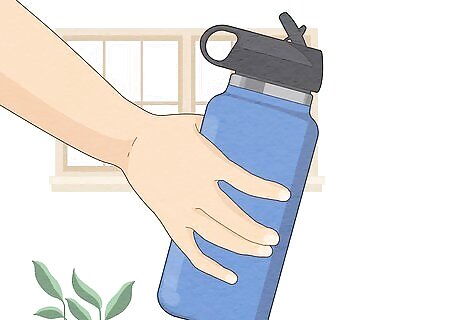
Drink water to stay hydrated. It’s easy to become dehydrated when you exercise. Keep your energy levels up and replace moisture that you lose through sweating by drinking about 16–32 fluid ounces (470–950 mL) of water for every 60 minutes of exercise. You may need to drink more if it’s hot or you’re sweating heavily. A great time to drink some water is during a break in between exercise sets. For example, if you do 2 sets of 20 squats, take a drink of water after the first 20 and after the last 20. If it’s really hot, humid, or you’re doing intense or long-lasting exercise (e.g., more than an hour), drink a sports drink to help replace lost electrolytes. Make sure to rehydrate by drinking some water after you exercise, too! You can also get fluids by drinking a nutritious shake or smoothie, eating some juicy fruits or vegetables, or having a bowl of soup.
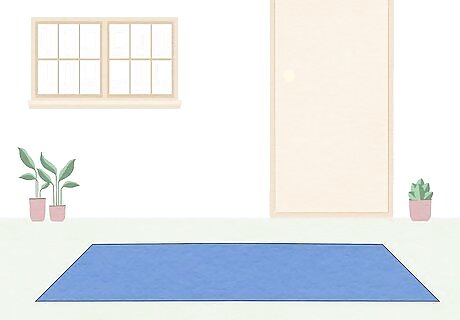
Choose a safe and comfortable space in your home for exercise. You don’t need a ton of space for a home workout, but you need enough room to move around without bumping into things and hurting yourself. Clear away any furniture that might get in the way, like chairs or coffee tables. Consider putting down a mat to protect yourself (and your floor) while you exercise. It’s also important to use a space that’s cool and well-ventilated since you’ll be breathing hard and working up a sweat! If you can’t open the windows, turn on a fan to help keep the air circulating.
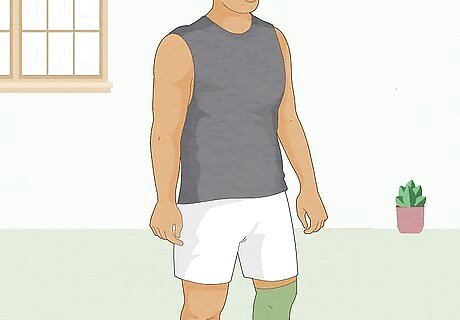
Wear comfortable clothes that you can move in easily. What you wear can make a big difference in your comfort level while you exercise. Choose clothes that are breathable and loose or flexible enough that they don’t restrict your movement. If you’re going to be sweating a lot, choose a moisture-wicking synthetic fabric, like polyester or polypropylene. If any part of your workout is going to take place outside, dress appropriately for the weather. Wear light-colored clothes and thin fabrics if it’s hot out. If it’s chilly, wear darker colors and add more layers. If you have large breasts, a comfortable, snug-fitting sports bra can provide extra comfort and support.
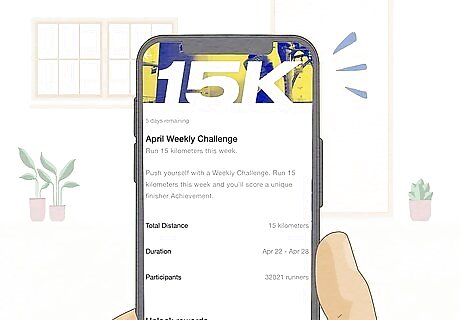
Participate in workout challenges to make it more fun. Doing a fitness challenge can help give you defined goals and make your workouts more exciting. Make a pledge with some friends to do a 30-day plank challenge or a Couch to 5K. Once you’ve spent a few weeks at it, you may find that the routines you established during the challenge have become new habits! Keep in mind that many of these fitness challenges don’t work out every part of your body, so it’s still best to combine them with other types of exercise. For instance, a squat challenge is great for working your legs and butt, but it won’t help you build strength in your upper body.Give your workout a boost with fitness challenge apps. You can also use fitness apps that have built-in challenges, like the Apple Watch fitness app, the Nike Run Club app, or the Home Workout – No Equipment app. These apps can help you easily track your progress towards your fitness challenge goals, and some even have social networking functions that let you compete with friends.



















Comments
0 comment